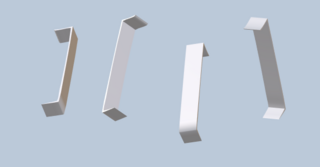
The Emperor of Ethiopia was the hereditary ruler of the Ethiopian Empire, from at least the 13th-century until the abolition of the monarchy in 1975. The Emperor was the head of state and head of government, with ultimate executive, judicial and legislative power in that country. A National Geographic article from 1965 called imperial Ethiopia "nominally a constitutional monarchy; in fact [it was] a benevolent autocracy".

The Zagwe dynasty was an Agaw-led medieval kingdom that ruled the northern parts of Ethiopia and Eritrea, after the historical name of the Lasta province. Centered at Lalibela, it ruled large parts of the territory from approximately 900 to 1270, when the last Zagwe King Za-Ilmaknun was killed in battle by the forces of the Abyssinian King Yekuno Amlak. The name of the dynasty is thought to derive from the ancient Ge'ez phrase Ze-Agaw, meaning "opponent", in reference to the Mara Tekle Haymanot, the founder of the dynasty. Zagwe's best-known King was Gebre Mesqel Lalibela, who is credited with having constructed the rock-hewn monolithic churches of Lalibela.
This is a list of monarchies of Ethiopia that existed throughout the nation's history. It is divided into kingdoms that were subdivisions of Ethiopia, and kingdoms that were later conquered by Ethiopia. Ancient kingdoms fall into neither category.

The Kingdom of Gera was a kingdom in the Gibe region of Ethiopia that emerged in the late 19th century. It shared its northern border with the Kingdom of Gumma, its eastern border with the Kingdom of Gomma, and was separated from the Kingdom of Kaffa to the south by the Gojeb River. With its capital at Chala (Cira), the Gera kingdom's territory corresponds approximately with the modern woreda of Gera.
The Gibe region was a historic region in modern southwestern Ethiopia, to the west of the Gibe and Omo Rivers, and north of the Gojeb. It was the location of the former Oromo and Sidama kingdoms of Gera, Gomma, Garo, Gumma, Jimma, and Limmu-Ennarea.

The Kingdom of Gomma was a kingdom in the Gibe region of Ethiopia that emerged in the 18th century. It was based in Agaro.

The Kingdom of Gumma was a kingdom in the Gibe region of Ethiopia that emerged in the 18th century. Its eastern border was formed by the bend of the Didessa River, which separated it from Limmu-Ennarea to the northeast, and the kingdoms of Gomma and Gera to the south. Beyond its northern border were various Macha Oromo groups, and to the west Sidamo groups. Its territory corresponds approximately with the modern woredas of Gechi, Borecha, and Didessa.

The Kingdom of Limmu-Ennarea was one of the kingdoms in the Gibe region of Ethiopia that emerged in the 19th century. It shared its eastern border with the Kingdom of Jimma, its southern border with the Kingdom of Gomma and its western border with the Kingdom of Gumma. Beyond its northern border lay tribes of the Macha Oromo. Jimma was considered the most civilized of the Gibe kingdoms, which had a population in the 1880s between 10,000 and 12,000. It was converted to Islam by missionaries from Harar in the first half of the 19th century; C.T. Beke, writing in 1841, reported that its "king and most of his subjects are Mohammedan." Limmu-Ennarea's capital was at Saqqa.

The Sultanate of Ifat, or Awfat was a medieval Sunni Muslim state in the eastern regions of the Horn of Africa between the late 13th century and early 15th century. It was formed in present-day Ethiopia around eastern Shewa or Zeila. Led by the Walashma dynasty, the polity stretched from Zequalla to the port city of Zeila. The kingdom ruled over parts of what are now Ethiopia, Djibouti and Somaliland.
This is a list of rulers and office-holders of Ethiopia.
Gumma or Guma may refer to:

Negus is a title in the Ethiopian Semitic languages. It denotes a monarch, such as the Negus Bahri of the Medri Bahri kingdom in pre-1890, and the negus in pre-1974 Ethiopia. The negus is referred to as Al-Najashi (النجاشي) in the Islamic tradition.

Kingdom of Wolaita, also known as Wolaita Kingdom, was a kingdom dominated by Wolayta people in southern Ethiopia from 1251 until conquest of Ethiopian Empire in 1894.